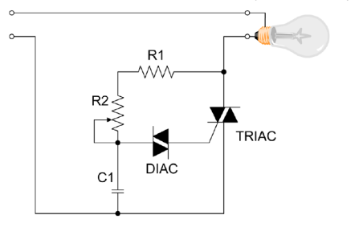
Power Dissipation
What is Power Dissipation? Explain with Examples. Power Dissipation is the transfer of energy from one form to another in an electrical circuit. Power dissipates when current flows through a resistance and produces heat, light or sound. Power dissipation can also occur when two or more circuits interact with each other, such as when one circuit supplies voltage to another circuit. Power dissipation is measured in watts (W) and is an important factor in the calculation of electrical circuit efficiency.
Power dissipation can result from a variety of causes, including current flowing through resistors, capacitors and inductors, as well as the interaction between two or more circuits.
How to Reduce the Power Dissipation?
Power dissipated by components in a circuit can be reduced by adding additional circuitry to reduce resistance, improve current flow or reduce inductive reactance. Power dissipation can also be reduced by using components that are better able to dissipate heat and other forms of radiation.
Power Dissipation is a major concern in electronics, as it can lead to overheating and permanent damage to electrical components. Power management systems are used to control power dissipation in electronic circuits and ensure proper operation. Power dissipation must be taken into account when designing and constructing electronic devices to ensure that components remain within their specified temperature ranges. Power Dissipation is also an important factor in the design of power supplies, which need to dissipate generated heat and voltage drops in order to avoid damage to connected components.
Power Dissipation calculation
Power Dissipation calculation is a crucial step in any power system design. Power dissipation calculations are used to determine the amount of power dissipated through a resistor or other component in a circuit, as well as its accompanying temperature rise. Power dissipation can also be used to calculate current flowing through an inductor and capacitor when combined with Ohm’s Law. Power Dissipation calculation is important as it helps to ensure that components in the circuit are not operating at levels which could cause damage or failure, and can also be used to determine the efficiency of a power system. Power dissipation calculations should take into account both the load current and voltage when determining the total dissipated power.
Additionally, thermal resistance can also be taken into account in Power Dissipation calculation to ensure that components are not operating at temperatures which would cause damage or failure. Power dissipation calculations should always be performed with accuracy and precision, as errors can lead to malfunctioning of the system and limit its safety and performance. Power Dissipation calculation is essential for ensuring a safe, efficient and reliable power system design.
Formula for Power Dissipation calculation
Power dissipated by a resistor is equal to the product of the voltage and current flowing through it.
Power Dissipated (P) = Voltage (V) x Current (I) or P=VI or P=V2/R
Therefore, in order to calculate power dissipation, one needs to determine the voltage and current values for a given circuit. Once these values are known, the formula can be used to calculate the total power dissipation in the circuit. Additionally, if thermal resistance is taken into account, one can use the power dissipation calculation to determine temperature rise of components or systems.
Example of Power Dissipation Calculation :
For example, consider a basic circuit with an 8 ohm resistor and 10 volts applied. Power dissipation can be calculated by taking the square of the voltage (100 Volts) and dividing it by the resistance (8 Ohms).

This gives us a total power dissipation of 12.5 watts. Additionally, if we take into account thermal resistance, we can calculate the temperature rise of the resistor due to power dissipation. With a thermal resistance of 0.2°C/W, the total temperature rise would be 2.5°C (12.5 watts X 0.2°C/W). Power dissipation calculations are an essential part of any power system design and should be performed with accuracy and precision to ensure safety and reliability. Power dissipation calculations can also be used to monitor the efficiency of a system or component and determine if any changes are needed for improved performance.
By understanding Power Dissipation calculation, power engineers can make sure that components in their circuits operate within safe operating temperatures, as well as maximizing the efficiency of their systems. Power Dissipation calculations should always be performed with accuracy and precision to ensure safety and reliability.
Power Dissipation in Series and Parallel Configurations
In a series configuration, power dissipation occurs when current is forced through a resistor, which in turn causes the power supply to dissipate more energy than it is meant to. In a parallel configuration, power dissipation occurs due to resistance imbalance between components that are connected in parallel, meaning the current splits unequally through them. Power dissipation can also be caused by an insufficient heat sink or improper ventilation.
Power Dissipation Calculation in Series Networks
Here is an example of power dissipation calculation for resistors connected in series. For the given circuit, we can use the following formula for calculating the power dissipation in series configuration:
Pt=PR1+ PR2+ PR3+ PR4
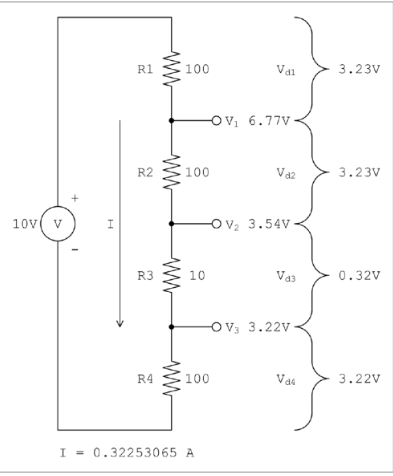
The voltage drop across each resistor can be added to check it is equal to the source voltages.
VS=VR1+ VR2+ VR3+ VR4
VS=3.23V+ 3.23V+ 0.32+ 3.22=10V
Finally you can apply the formula P=V2/R for calculating the power dissipation across each resistor. You can also calculate the total current of the network and then apply the formula P=I2R where I is the total current and R is the equivalent resistance of this circuit.
Hence power dissipated in this circuit is Equal to I=V/R=10/310=0.03226A and hence P=I2R= (0.032262)(310)=0.322W

or the following table depicts the power drop across each resistor which is then finally added in case of series resistors.
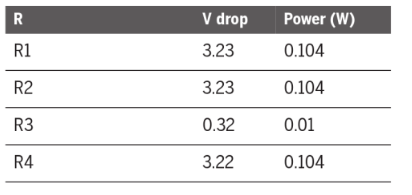
Power Dissipation Calculation in Parallel Networks
Consider the following configuration where the resistors are connected in parallel for power dissipation calculation.
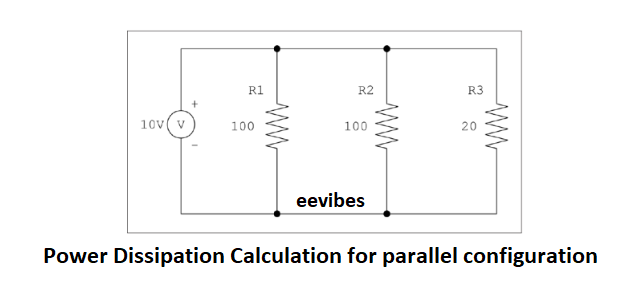
The total resistance of the parallel network circuit is calculated as:
The equivalent resistance calculated in this case is: 14.28Ω. In parallel network, voltage across each resistor is same but current is different and the total current is calculated as:
IT=I1+ I2+ I3+………+ In
After calculating R and total current, we can use the formula P=I2R for calculating the total power dissipated in this circuit. The following table shows the calculation results:
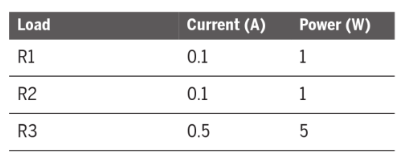
hence the total power dissipated in this case is 7W.
It is important for engineers to understand how power dissipation in series and parallel configurations works so that they can design circuits with proper power management. To reduce the amount of power dissipated, engineers must choose components with low resistance values and maximize voltage efficiency. Furthermore, using heat sinks or other cooling methods will help to reduce the amount of energy.
Also read here
